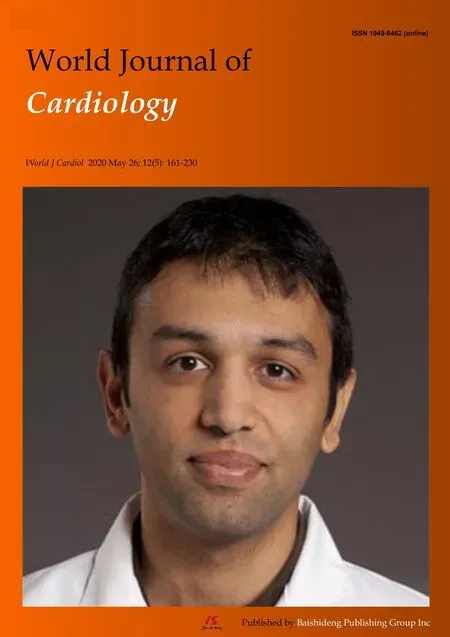Management of hypertension in COVID-19
Daniel Antwi-Amoabeng, Bryce D Beutler, Alastair E Moody, Zahara Kanji, Nageshwara Gullapalli,Christopher J Rowan
Abstract
Key words: Angiotensin converting enzyme inhibitor; Angiotensin receptor blocker;Carvedilol; Coronavirus disease-19; COVID-19; SARS-CoV-2; Verapamil
TO THE EDITOR
Coronavirus disease-19 (COVID-19) has emerged as a major cause of morbidity and mortality worldwide. As of this writing, over half a million cases of severe acute respiratory syndrome coronavirus 2 (SARS-CoV-2) infections have been recorded. A global arms race for a vaccine or viable therapy is currently underway. However,most experts project that development of a vaccine will take at least 18 mo[1], and an effective pharmacologic treatment has yet to be discovered. It therefore appears increasingly likely that COVID-19 will become embedded in the fabric of modern medicine for years to come.
Management of chronic illnesses in patients with COVID-19 should be considered a priority. Hypertension affects over 1.4 billion individuals worldwide[2]and has been associated with markedly increased morbidity and mortality in the setting of COVID-19[3,4]. Angiotensin-converting enzyme inhibitors (ACEIs) and angiotensin receptor blockers (ARBs) are among the most frequently prescribed antihypertensive agents throughout most of the developed world[5]. These drugs are safe, well-tolerated, and effective as a first-line therapy. However, emerging evidence suggests that ACEIs and ARBs may increase patient susceptibility to SARS-CoV-2 host cell entry and propagation by upregulation of the angiotensin-converting enzyme 2 (ACE2) viral binding site[6-8].
There is insufficient data to recommend withdrawal of ACEIs and ARBs among individuals who have been diagnosed with COVID-19. Indeed, most major medical organizations - including the American Heart Association and European Society of Cardiology - recommend maintaining ACEI or ARB therapy in all hypertensive patients with COVID-19. However, we propose that an alternative agent should be considered in patients presenting with COVID-19 and a new diagnosis of hypertension.
Verapamil is a non-dihydropyridine calcium channel blocker that was once used for the management of hypertension. It has largely been supplanted by ACEIs, ARBs,and dihydropyridine calcium channel blockers; in the modern era, verapamil is primarily used for rate control in supraventricular tachycardia, migraine prophylaxis,and hypertension with co-morbid atrial fibrillation. We believe that this drug may be appropriate as a first-line agent for the management of hypertension in patients with COVID-19. Preliminary data from animal studies have demonstrated that verapamil has no effect on ACE2 expression. Furthermore, it has been shown to ameliorate the clinical and pathological course of viral myocarditis in murine models. Indeed, in a study of mice inoculated with encephalomyocarditis virus, investigators found that those treated with verapamil before and/or during infection exhibited markedly less cardiac inflammation and necrosis as compared to an untreated group[9]. Cardiac involvement - and, specifically, SARS-CoV-2-associated myocarditis - represents a serious and potentially fatal manifestation of COVID-19[10]. Management of hypertension with a drug that may reduce inflammation in viral myocarditis and does not pose a theoretical risk of promoting COVID-19 proliferation would appear to be a rational strategy to optimize patient outcomes.
Carvedilol, a nonselective β-adrenoreceptor antagonist with additional α1-adrenergic blocking properties, represents another promising antihypertensive agent in the setting of COVID-19. Similar to verapamil, carvedilol attenuates inflammation in murine models of acute viral myocarditis. In a study of mice infected with coxsackie B3 virus, those receiving carvedilol exhibited superior survival as compared to an untreated group and those treated with metoprolol[11]. The mechanism of action is unclear, but it has been postulated that carvedilol exerts anti-inflammatory effects via inhibition of peroxidants in the myocardium. Carvedilol also has the added benefit of reducing heart rate, which may reduce myocyte injury and ventricular remodeling in the setting of myocarditis[12].
Notably, there are demonstrable anti-inflammatory effects associated with upregulation of ACE2. Indeed, lung function improvement with ACEI or ARB treatment has been described in the setting of COVID-19[13]. However, irrespective of the purported benefits of ACEIs and ARBs, the potential of these agents to facilitate viral disease remains under investigation.
In conclusion, we believe that verapamil or carvedilol should be considered for the management of hypertension in patients at risk of COVID-19. The pathogenic mechanisms of SARS-CoV-2 remain under investigation, but data suggest that the ACE2 receptor plays a central role in infection. It is therefore theoretically possible that drugs known to increase ACE2 expression, such as ACEIs and ARBs, could promote COVID-19 proliferation. We are in agreement with the recommendation of major medical societies to maintain ACEI or ARB therapy in individuals who are already receiving treatment. However, patients with a new diagnosis of hypertension who are at risk of COVID-19 would likely benefit from verapamil or carvedilol, as these agents effectively control blood pressure and may conceivably attenuate inflammation and necrosis in SARS-CoV-2 myocarditis.
 World Journal of Cardiology2020年5期
World Journal of Cardiology2020年5期
- World Journal of Cardiology的其它文章
- Incidental discovery of right ventricular lipoma in a young female aImaging investigations and diagnosissociated with ventricular hyperexcitability: An imaging multimodality approach
- Preoperative nuclear stress testing in the very old patient population
- Access to smart devices and utilization of online health resources among older cardiac rehabilitation participants
- Nicotine-induced adrenal beta-arrestin1 upregulation mediates tobacco-related hyperaldosteronism leading to cardiac dysfunction
- Management of adults with coarctation of aorta
- New guidelines for the diagnosis and management of pulmonary embolism: Key changes
